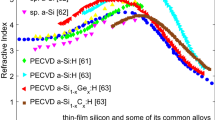Abstract
Optical losses are a barrier to use of ferroelectric waveguide thin films. Losses of about 2 dB/cm will reduce the efficiency of a frequency doubler by over 50%. Achieving losses on this order in conjunction with other essential film properties is difficult. The optical loss has several origins, including absorption, mode leakage, internal scattering and surface scattering. When the film surface morphology is accurately known, it is possible to estimate the surface scattering component of the loss. We have employed atomic force microscopy and computer modeling to compute, and correlate the optical loss as a function of film thickness and wavelength. The results suggest upper limits to the morphological roughness for various device applications. For lithium niobate films on sapphire which are intended to frequency double into the blue part of the spectrum, the optimal film thickness is about 400 nm and the RMS roughness is constrained below about 1.0 nm, with some weak dependence on grain size. Although present growth techniques do not appear to achieve this level of surface flatness intrinsically, an understanding of the morphological development of the film structure may lead to improvements.
Similar content being viewed by others
References
G. F. Lipscomb, R. S. Lytel, A. J. Ticknor, J. Kenny, T. E. Van Eck, D. G. Girton, and E. Binkley, Proc. Mater. Res. Soc. Symp., 228, 15 (1992).
W. P. Risk, Optics and Photonics News, 1(5), 10 (1990).
K. Nashimoto, D. K. Fork, and T. H. Geballe, Appl. Phys. Lett., 60, 1199 (1992).
W-Y Hsu, and R. Raj, Appl. Phys. Lett., 60, 3105 (1992).
D.K. Fork and G. B. Anderson, Appl. Phys. Lett. 63, 1029 (1993).
L. S. Hung, J. A. Agostinelli, J. M. Mir, and L. R. Zheng, Appl. Phys. Lett., 62, 3071 (1993).
R. Gutmann, J. Huliger, R. Hauert, and E. M. Moser, J. Appl. Phys., 70, 2648 (1991).
H. Nishihara, M. Haruna and T. Suhara, Optical Integrated Circuits, p. 167–168, Mc Graw Hill Optical and Electro-optical engineering series, New York 1989.
S. Schwyn Thöny, H. W. Lehman, and P. Günter, Appl. Phys. Lett., 61, 373 (1992).
T. M. Graettinger, S. H. Rou, M. S. Ameen, O. Auciello, and A. I. Kingon, Appl. Phys. Lett., 8, 1964 (1991).
J. J. Kingston, D. K. Fork, F. Leplingard, F. A. Ponce, Mat. Res. Soc. Symp. Proc., 341, 289 (1994).
D. Marcuse, Theory of Dielectric Optical Waveguides, (Academic Press, New York, 1974), Chap. 3.
D. Marcuse, Bell Sys. Tech. J., p. 3187, Dec. 1969.
pseudo-even and pseudo-odd designate modes which are truly odd or even in the limit of a symmetric slab guide.
D. K. Fork, F. Armani-Leplingard, and J. J. Kingston, proceedings of the 6th International Symposium on Integrated Ferroelectrics, vol. 6, part 1, March 1994, Monterey CA.
Author information
Authors and Affiliations
Rights and permissions
About this article
Cite this article
Fork, D.K., Armani-Leplingard, F. & Kingston, J.J. Optical Losses in Ferroelectric Oxide Thin Films: Is There Light at the end of the Tunnel?. MRS Online Proceedings Library 361, 155–166 (1994). https://doi.org/10.1557/PROC-361-155
Published:
Issue Date:
DOI: https://doi.org/10.1557/PROC-361-155



